Tropospheric and Ionospheric Anomalies Induced by Volcanic and Saharan Dust Events as Part of Geosphere Interaction Phenomena
Abstract
1. Introduction
2. Background
3. Data
3.1. DEMETER
3.2. AVHRR and SEVIRI
3.3. GPS TEC
4. Methods
4.1. DEMETER Methodology
4.2. RST Approach
4.3. Analysis of OLR Anomalies
4.4. Analysis of GPS TEC Anomalies
4.5. Atmospheric Chemical Potential (ACP) Correction Approach
5. Analyzed Events
5.1. Mt. Etna Activity of November–December 2006
5.2. Saharan Dust Events of May 2008
6. Results
6.1. Ionospheric Perturbations of November–December 2006
6.2. Ionospheric Perturbations of May 2008
7. Discussion
8. Conclusions
Author Contributions
Funding
Acknowledgments
Conflicts of Interest
References
- Cheng, K.; Huang, Y.N. Ionospheric disturbances observed during the period of Mount Pinatubo eruptions in June 1991. J. Geophys. Res. 1992, 97, 16995–17004. [Google Scholar] [CrossRef]
- Igarashi, K.; Kainuma, S.; Nishimuta, I.; Okamoto, S.; Kuroiwa, H.; Tanaka, T.; Ogawa, T. Ionospheric and atmospheric disturbances around Japan caused by the eruption of Mount Pinatubo on 15 June 1991. J. Atmos. Terr. Phys. 1994, 56, 1227–1234. [Google Scholar] [CrossRef]
- Zlotnicki, J.; Le Mouël, J.L.; Kanwar, R.; Yvetot, P.; Vargemezis, G.; Menny, P.; Fauquet, F. Ground-based electromagnetic studies combined with remote sensing based on Demeter mission: A way to monitor active faults and volcanoes. Planet. Space Sci. 2006, 54, 541–557. [Google Scholar] [CrossRef]
- Zlotnicki, J.; Li, F.; Parrot, M. Signals recorded by DEMETER satellite over active volcanoes during the period 2004 August–2007 December. Geophys. J. Int. 2010, 183, 1332–1347. [Google Scholar] [CrossRef]
- Zlotnicki, J.; Li, F.; Parrot, M. Ionospheric Disturbances Recorded by DEMETER Satellite over Active Volcanoes: From August 2004 to December 2010. Int. J. Geophys. 2013, 2013, 530865. [Google Scholar] [CrossRef]
- Rozhnoi, A.; Hayakawa, M.; Solovieva, M.; Hobara, Y.; Fedun, V. Ionospheric effects of the Mt. Kirishima volcanic eruption as seen from subionospheric VLF observations. J. Atmos. Sol.-Terr. Phys. 2014, 107, 54–59. [Google Scholar] [CrossRef]
- Piscini, A.; Marchetti, D.; De Santis, A. Multi-parametric climatological analysis associated with global significant volcanic eruptions during 2002–2017. Pure Appl. Geophys. 2019, in press. [Google Scholar] [CrossRef]
- Gringel, W.; Rosen, J.M.; Hofmann, D.J. Electrical Structure from 0 to 30 km Atmospheric Electricity in the Planetary Boundary Layer: The Earth’s Electrical Environment; National Academic Press: Washington, DC, USA, 1986; pp. 166–182. [Google Scholar]
- Pulinets, S.A.; Boyarchuk, K.A.; Khegai, V.V.; Kim, V.P.; Lomonosov, A.M. Quasi electrostatic model of atmosphere–thermosphere–ionosphere coupling. Adv. Space Res. 2000, 26, 1209–1218. [Google Scholar] [CrossRef]
- Ulanowski, Z.; Bailey, J.; Lucas, P.W.; Hough, J.H.; Hirst, E. Alignment of atmospheric mineral dust due to electric field. Atmos. Chem. Phys. 2007, 7, 6161–6173. [Google Scholar] [CrossRef]
- Pulinets, S.; Davidenko, D. Ionospheric precursors of earthquakes and global electric circuit. Adv. Space Res. 2014, 53, 709–723. [Google Scholar] [CrossRef]
- Melnik, O.; Parrot, M. Electrostatic discharge in Martian dust storms. J. Geophys. Res. 1998, 103, 29107–29118. [Google Scholar] [CrossRef]
- Stow, C.D. Dust and sand storm electrification. Weather 1969, 24, 134–140. [Google Scholar] [CrossRef]
- Freier, G.D. The electric field of a large dust devil. J. Geophys. Res. 1960, 65, 3504. [Google Scholar] [CrossRef]
- Crozier, W.D. Dust devil properties. J. Geophys. Res. 1970, 75, 4583–4585. [Google Scholar] [CrossRef]
- Kamra, A.K. Measurements of the electrical properties of dust storms. J. Geophys. Res. 1972, 77, 5856–5869. [Google Scholar] [CrossRef]
- Kamra, A.K. Effect of Dust-Raising Winds on the Atmospheric Electric Field. In Electrical Processes in Atmosphere; Dolezalek, H., Reiter, R., Eds.; Steinkopff: Darmstadt, Germany, 1977; pp. 168–174. [Google Scholar]
- Schmidt, D.S.; Schmidt, R.A.; Dent, J.D. Electrostatic force on saltating sand. J. Geophys. Res. Atmos. 1998, 103, 8997–9001. [Google Scholar] [CrossRef]
- Jackson, T.L.; Farrell, W.M. Electrostatic fields in dust devils: An analog to Mars. IEEE Trans. Geosci. Remote Sens. 2006, 44, 2942–2949. [Google Scholar] [CrossRef]
- Renno, N.O.; Kok, J.F. Electrical activity and dust lifting on Earth, Mars, and beyond. In Planetary Atmospheric Electricity; Springer: New York, NY, USA, 2008; pp. 419–434. [Google Scholar]
- Zhang, H.F.; Wang, T.; Qu, J.J.; Yan, M.H. An experimental and observational study on the electric effect of sandstorms. Chin. J. Geophys. 2004, 47, 53–60. [Google Scholar] [CrossRef]
- Saunders, C.P.R. Thunderstorm electrification. In Handbook of Atmospheric Electrodynamics; Volland, H., Ed.; CRC Press: Boca Raton, FL, USA, 1995; pp. 61–92. [Google Scholar]
- Brook, M.C.; Moore, B.; Sigurgeirsson, T. Lightning in volcanic clouds. J. Geophys. Res. 1974, 79, 472–475. [Google Scholar] [CrossRef]
- Brantley, S.R. The eruption of Redoubt volcano, Alaska, December 14, 1989–August 31, 1990, U.S. Geol. Surv. Circ. 1990, 1061, 33. [Google Scholar]
- Paskievitch, J.F.; Murray, T.L.R.; Hoblitt, P.; Neal, C.A. Lightning associated with the August 18, 1992, eruption of Crater Peak vent, Mount Spurr volcano, Alaska. In The 1992 Eruptions of Crater Peak Vent, Mount Spurt Volcano, Alaska; Keith, T.E.C., Ed.; US Government Printing Office: Washington, DC, USA, 1995; Volume 2139, pp. 179–182. [Google Scholar]
- McNutt, S.R.; Davis, C.M. Lightning associated with the 1992 eruptions of Crater Peak Mount Spurr volcano, Alaska. J. Volcanol. Geotherm. Res. 2000, 102, 45–65. [Google Scholar] [CrossRef]
- Thomas, R.J.; Krehbiel, P.R.; Rison, W.; Edens, H.E.; Aulich, G.D.; Winn, W.P.; McNutt, S.R.; Tytgat, G.; Clark, E. Electrical activity during the 2006 Mount St. Augustine volcanic eruptions. Science 2007, 315, 1097. [Google Scholar] [CrossRef] [PubMed]
- Aizawa, K.; Yokoo, A.; Kanda, W.; Ogawa, Y.; Iguchi, M. Magnetotelluric pulses generated by volcanic lightning at Sakurajima volcano, Japan. Geophys. Res. Lett. 2010, 37, L17301. [Google Scholar] [CrossRef]
- Behnke, S.A.; Thomas, R.J.; McNutt, S.R.; Schneider, D.J.; Krehbiel, P.R.; William, R.; Edens, H.E. Observations of volcanic lightning during the 2009 eruption of Redoubt Volcano. J. Volcanol. Geotherm. Res. 2013, 259, 214–234. [Google Scholar] [CrossRef]
- Behnke, S.A.; Thomas, R.J.; Edens, H.E.; Krehbiel, P.R.; Rison, W. The 2010 eruption of Eyjafjallajökull: Lightning and plume charge structure. J. Geophys. Res. Atmos. 2014, 119, 833–859. [Google Scholar] [CrossRef]
- Antel, C.; Collier, A.B.; Lichtenbergerand, J.; Rodger, C.J. Investigating Dunedin whistlers using volcanic lightning. Geophys. Res. Lett. 2014, 41, 4420–4426. [Google Scholar] [CrossRef]
- James, M.R.; Lane, S.J.; Gilbert, J.S. Volcanic plume electrification: Experimental investigation of a fracture-charging mechanism. J. Geophys. Res. 2000, 105, 16641–16649. [Google Scholar] [CrossRef]
- James, M.R.; Wilson, L.; Lane, S.J.; Gilbert, J.S.; Mather, T.A.; Harrison, R.G.; Martin, R.S. Electrical charging of volcanic plumes. Space Sci. Rev. 2008, 137, 399–418. [Google Scholar] [CrossRef]
- Mather, T.A.; Harrison, R.G. Electrification of volcanic plumes. Surv. Geophys. 2006, 27, 387–432. [Google Scholar] [CrossRef]
- Arason, P.; Bennett, A.J.; Burgin, L.E. Charge mechanism of volcanic lightning revealed during the 2010 eruption of Eyjafjallajökull. J. Geophys. Res. 2011, 116, B00C03. [Google Scholar] [CrossRef]
- McNutt, S.R.; Williams, E.R. Volcanic lightning: Global observations and constraints on source mechanisms. Bull. Volcanol. 2010, 72, 1153–1167. [Google Scholar] [CrossRef]
- Berthelier, J.J.; Godefroy, M.; Leblanc, F.; Seran, E.; Peschard, D.; Gilbert, P.; Artru, J. IAP, the thermal plasma analyzer on DEMETER. Planet. Space Sci. 2006, 54, 487–501. [Google Scholar] [CrossRef]
- Lebreton, J.P.; Stverak, S.; Travnicek, P.; Maksimovic, M.; Klinge, D.; Merikallio, S.; Lagoutte, D.; Poirier, B.; Kozacek, Z.; Salaquarda, M. The ISL Langmuir Probe experiment and its data processing onboard DEMETER: Scientific objectives, description and first results. Planet. Space Sci. 2005, 54, 472–486. [Google Scholar] [CrossRef]
- Berthelier, J.J.; Godefroy, M.; Leblanc, F.; Malingre, M.; Menvielle, M.; Lagoutte, D.; Brochot, J.Y.; Colin, F.; Elie, F.; Legendre, C.; et al. ICE The electric field experiment on DEMETER. Planet. Space Sci. 2006, 54, 456–471. [Google Scholar] [CrossRef]
- Higgins, J.; Harris, A. VAST: A program to locate and analyse volcanic thermal anomalies automatically from remotely sensed data. Comput. Geosci. 1997, 23, 627–645. [Google Scholar] [CrossRef]
- Pergola, N.; Marchese, F.; Tramutoli, V. Automated detection of thermal features of active volcanoes by means of infrared AVHRR records. Remote Sens. Environ. 2004, 93, 311–327. [Google Scholar] [CrossRef]
- Marchese, F.; Filizzola, C.; Genzano, N.; Mazzeo, G.; Pergola, N.; Tramutoli, V. Assessment and improvement of a robust satellite technique (RST) for thermal monitoring of volcanoes. Remote Sens. Environ. 2011, 115, 1556–1563. [Google Scholar] [CrossRef]
- Piscini, A.; Lombardo, V. Volcanic hot spot detection from optical multispectral remote sensing data using artificial neural networks. Geophys. J. Int. 2014, 196, 1525–1535. [Google Scholar] [CrossRef]
- Marchese, F.; Neri, M.; Falconieri, A.; Lacava, T.; Mazzeo, G.; Pergola, N.; Tramutoli, V. The Contribution of Multi-Sensor Infrared Satellite Observations to Monitor Mt. Etna (Italy) Activity during May to August 2016. Remote Sens. 2018, 10, 1948. [Google Scholar] [CrossRef]
- Prata, A.J. Observations of volcanic ash clouds in the 10–12mm window using AVHRR/2 data. Int. J. Remote Sens. 1989, 10, 751–761. [Google Scholar] [CrossRef]
- Prata, A.J. Infrared radiative transfer calculations for volcanic ash clouds. Geophys. Res. Lett. 1989, 16, 1293–1296. [Google Scholar] [CrossRef]
- Francis, P.N.; Cooke, M.C.; Saunders, R.W. Retrieval of physical properties of volcanic ash using Meteosat: A case study from the 2010 Eyjafjallajökull eruption. J. Geophys. Res. 2012, 117, D00U09. [Google Scholar] [CrossRef]
- Prata, A.J.; Prata, A.T. Eyjafjallajökull volcanic ash concentrations determined using Spin Enhanced Visible and Infrared Imager measurements. J. Geophys. Res. Atmos. 2012, 117, 1–23. [Google Scholar] [CrossRef]
- Guéhenneux, Y.; Gouhier, M.; Labazuy, P. Improved space borne detection of volcanic ash for real-time monitoring using 3-Band method. J. Volcanol. Geotherm. Res. 2015, 293, 25–45. [Google Scholar] [CrossRef]
- Li, J.; Zhang, P.; Schmit, T.J.; Schmetz, J.; Menzel, W.P. Technical note: Quantitative monitoring of a Saharan dust event with SEVIRI on Meteosat-8. Int. J. Remote Sens. 2007, 28, 2181–2186. [Google Scholar] [CrossRef]
- Klüser, L.; Schepanski, K. Remote sensing of mineral dust over land with MSG infrared channels: A new Bitemporal Mineral Dust Index. Remote Sens. Environ. 2009, 113, 1853–1867. [Google Scholar] [CrossRef]
- Sannazzaro, F.; Filizzola, C.; Marchese, F.; Corrado, R.; Paciello, R.; Mazzeo, G.; Pergola, N.; Tramutoli, V. Identification of dust outbreaks on infrared MSG-SEVIRI data by using a Robust Satellite Technique (RST). Acta Astronaut. 2014, 93, 64–70. [Google Scholar] [CrossRef]
- Tramutoli, V. Robust AVHRR Techniques (RAT) for Environmental Monitoring: Theory and applications. In Earth Surface Remote Sensing II, Proceedings of SPIE; Zilioli, E., Ed.; SPIE Press: Bellingham, WA, USA, 1998; Volume 3496, pp. 101–113. [Google Scholar]
- Tramutoli, V. Robust Satellite Techniques (RST) for Natural and Environmental Hazards Monitoring and Mitigation: Theory and Applications. In Proceedings of the 2007 International Workshop on the Analysis of Multi-temporal Remote Sensing Images, Leuven, Belgium, 18–20 July 2007. [Google Scholar] [CrossRef]
- Sardón, E.; Rius, A.; Zarrao, N. Estimation of the transmitter and receiver differential biases and the ionospheric total electron content from global positioning system observation. Radio Sci. 1994, 29, 577–589. [Google Scholar] [CrossRef]
- Liu, J.Y.; Tsai, H.F.; Jung, T.K. Total electron content obtained by using the global positioning system. Terr. Atmos. Ocean. Sci. 1996, 7, 107–117. [Google Scholar] [CrossRef]
- Tsai, H.F.; Liu, J.Y. Ionospheric total electron content response to solar eclipses. J. Geophys. Res. 1999, 104, 12657–12668. [Google Scholar] [CrossRef]
- Němec, F.; Santolík, O.; Parrot, M. Decrease of Intensity of ELF/VLF Waves observed in the Upper Ionosphere close to Earthquakes: A Statistical Study. J. Geophys. Res. Space Phys. 2009, 114, 1–10. [Google Scholar] [CrossRef]
- He, Y.; Yang, D.; Qian, J.; Parrot, M. Response of the ionospheric electron density to different types of seismic events. Nat. Hazards Earth Syst. Sci. 2011, 11, 2173–2180. [Google Scholar] [CrossRef]
- Píša, D.; Němec, F.; Santolík, O.; Parrot, M.; Rycroft, M. Additional attenuation of natural VLF electromagnetic waves observed by the DEMETER spacecraft resulting from pre-seismic activity. J. Geophys. Res. Space Phys. 2013, 118, 5286–5295. [Google Scholar] [CrossRef]
- Eleftheriou, A.; Filizzola, C.; Genzano, N.; Lacava, T.; Lisi, M.; Paciello, R.; Pergola, N.; Vallianatos, F. Long-Term RST Analysis of Anomalous TIR Sequences in Relation with Earthquakes Occurred in Greece in the Period 2004–2013. Pure Appl. Geophys. 2016, 173, 285–303. [Google Scholar] [CrossRef]
- Lacava, T.; Filizzola, C.; Pergola, N.; Sannazzaro, F.; Tramutoli, V. Improving flood monitoring by the Robust AVHRR Technique (RAT) approach: The case of the April 2000 Hungary flood. Int. J. Remote Sens. 2010, 31, 2043–2062. [Google Scholar] [CrossRef]
- Grimaldi, C.S.L.; Casciello, D.; Coviello, I.; Lacava, T.; Pergola, N.; Tramutoli, V. An improved RST approach for timely alert and Near Real Time monitoring of oil spill disasters by using AVHRR data. Nat. Hazards Earth Syst. Sci. 2011, 11, 1281–1291. [Google Scholar] [CrossRef]
- Filizzola, C.; Corrado, R.; Marchese, F.; Mazzeo, G.; Paciello, R.; Pergola, N.; Tramutoli, V. Erratum to RST-FIRES, an exportable algorithm for early-fire detection and monitoring: Description, implementation, and field validation in the case of the MSG-SEVIRI sensor. Remote Sens. Environ. 2017, 186, 196–216. [Google Scholar] [CrossRef]
- Marchese, F.; Mazzeo, G.; Coviello, I.; Falconieri, A.; Filizzola, C.; Lacava, T.; Pergola, N.; Tramutoli, V. Issues and possible improvements in winter fires detection by satellite radiances analysis: Lesson learnt in two regions of Northern Italy. J. Sel. Top. Appl. Earth Obs. Remote Sens. 2017, 10, 3297–3313. [Google Scholar] [CrossRef]
- Marchese, F.; Falconieri, A.; Pergola, N.; Tramutoli, V. A retrospective analysis of the Shinmoedake (Japan) eruption of 26–27 January 2011 by means of Japanese geostationary satellite data. J. Volcanol. Geotherm. Res. 2014, 269, 1–13. [Google Scholar] [CrossRef]
- Pergola, N.; Tramutoli, V.; Marchese, F.; Scaffidi, I.; Lacava, T. Improving volcanic ash cloud detection by a robust satellite technique. Remote Sens. Environ. 2004, 90, 1–22. [Google Scholar] [CrossRef]
- Marchese, F.; Sannazzaro, F.; Falconieri, A.; Filizzola, C.; Pergola, N.; Tramutoli, V. An enhanced satellite-based algorithm for detecting and tracking dust outbreaks by means of SEVIRI data. Rem. Sens. 2017, 9, 537. [Google Scholar] [CrossRef]
- Ouzounov, D.; Pulinets, S.; Romanov, A.; Romanov, A.; Tsybulya, K.; Davidenko, D.; Kafatos, M.; Taylor, P. Atmosphere-Ionosphere Response to the M9 Tohoku Earthquake Reviled by Joined Satellite and Ground Observations. Earthq. Sci. 2011, 24, 557–564. [Google Scholar] [CrossRef]
- Ouzounov, D.; Pulinets, S.; Hattori, K.; Taylor, P. Pre-Earthquake Processes: A Multi-disciplinary Approach to Earthquake Prediction Studies; AGU/Wiley: Hoboken, NJ, USA, 2018; Volume 385. [Google Scholar]
- Ouzounov, D.; Liu, D.; Kang, C.; Cervone, G.; Kafatos, M.; Taylor, P. Outgoing Long Wave Radiation Variability from IR Satellite Data Prior to Major Earthquakes. Tectonophysics 2007, 431, 211–220. [Google Scholar] [CrossRef]
- Tramutoli, V.; Di Bello, G.; Pergola, N.; Piscitelli, S. Robust satellite techniques for remote sensing of seismically active areas. Ann. Geophys. 2001, 44, 295–312. [Google Scholar]
- Tramutoli, V.; Cuomo, V.; Filizzola, C.; Pergola, N.; Pietrapertosa, C. Assessing the potential of thermal infrared satellite surveys for monitoring seismically active areas: The case of Kocaeli (Izmit) earthquake, August 17, 1999. Remote Sens. Environ. 2005, 96, 409–426. [Google Scholar] [CrossRef]
- Hernández-Pajares, M.; Juan, J.; Sanz, J.; Orus, R.; Garcia-Rigo, A.; Feltens, J.; Komjathy, A.; Schaer, S.C.; Krankowski, A. The IGS VTEC maps: A reliable source of ionospheric information since 1998. J. Geod. 2009, 83, 263–275. [Google Scholar] [CrossRef]
- Pulinets, S.; Ouzounov, D.; Karelin, A.V.; Davidenko, D. Physical bases of the generation of short-term earthquake precursors: A complex model of ionization-induced geophysical processes in the lithosphere-atmosphere-ionosphere-magnetosphere system. Geomagn. Aeron. 2015, 55, 521–538. [Google Scholar] [CrossRef]
- Calvari, S.; Neri, M.; Pinkerton, H. Effusion rate estimations during the 1999 summit eruption on Mt. Etna, and growth of two distinct lava flow fields. J. Volcanol. Geotherm. Res. 2002, 119, 107–123. [Google Scholar] [CrossRef]
- Behncke, B.; Neri, M. The July–August 2001 eruption of Mt. Etna (Sicily). Bull. Volcanol. 2003, 65, 461–476. [Google Scholar] [CrossRef]
- Branca, S.; Del Carlo, P. Types of eruptions of Etna volcano AD 1670–2003: Implications for short-term eruptive behavior. Bull. Volcanol. 2005, 67, 732–742. [Google Scholar] [CrossRef]
- Salvi, F.; Scandone, R.; Palma, C. Statistical analysis of the historical activity of Mount Etna, aimed at the evaluation of volcanic hazard. J. Volcanol. Geotherm. Res. 2006, 154, 159–168. [Google Scholar] [CrossRef]
- Del Negro, C.; Cappello, A.; Neri, M.; Bilotta, G.; Hérault, A.; Ganci, G. Lava flow hazards at Mount Etna: Constraints imposed by eruptive history and numerical simulations. Sci. Rep. 2013, 3. [Google Scholar] [CrossRef]
- Neri, M.; Behncke, B.; Burton, M.; Galli, G.; Giammanco, S.; Pecora, E.; Privitera, E.; Reitano, D. Continuous soil radon monitoring during the July 2006 Etna eruption. Geophys. Res. Lett. 2006, 33, L24316. [Google Scholar] [CrossRef]
- Andronico, D.; Scollo, S.; Cristaldi, A.; Ferrari, F. Monitoring ash emission episodes at Mt. Etna: The 16 November 2006 case study. J. Volcanol. Geotherm. Res. 2009, 180, 123–134. [Google Scholar] [CrossRef]
- Global Volcanism Program. Report on Etna (Italy). In Bulletin of the Global Volcanism Network 31:10, Smithsonian Institution; Wunderman, R., Ed.; Global Volcanism Program: Washington, DC, USA, 2006; Available online: http://volcano.si.edu/showreport.cfm?doi=10.5479/si.GVP.BGVN200610-211060 (accessed on 17 January 2019).
- Global Volcanism Program. Report on Etna (Italy). In Bulletin of the Global Volcanism Network 31:8, Smithsonian Institution; Wunderman, R., Ed.; Global Volcanism Program: Washington, DC, USA, 2006; Available online: https://doi.org/10.5479/si.GVP.BGVN200608-211060 (accessed on 12 April 2019).
- Andronico, D.; Spinetti, C.; Cristaldi, A.; Buongiorno, M.F. Observations of Mt. Etna volcanic ash plumes in 2006: An integrated approach from ground-based and polar satellite NOAA–AVHRR monitoring system. J. Volcanol. Geotherm. Res. 2009, 180, 135–147. [Google Scholar] [CrossRef]
- Amiridis, V.; Kafatos, M.; Perez, C.; Kazadzis, S.; Gerasopoulos, E.; Mamouri, R.E.; Papayannis, A.; Kokkalis, P.; Giannakaki, E.; Basart, S.; et al. The Potential of the Synergistic Use of Passive and Active Remote Sensing Measurements for the Validation of a Regional Dust Model. Ann. Geophys. 2009, 27, 3155–3164. [Google Scholar] [CrossRef]
- Bègue, N.; Tulet, P.; Chaboureau, J.P.; Roberts, G.; Gomes, L.; Mallet, M. Long-range transport of Saharan dust over northwestern Europe during EUCAARI 2008 campaign: Evolution of dust optical properties by scavenging. J. Geophys. Res. 2012, 117, D17201. [Google Scholar] [CrossRef]
- Wiegner, M.; Groß, S.; Freudenthaler, V.; Schnell, F.; Gasteiger, J. The May/June 2008 Saharan dust event over Munich: Intensive aerosol parameters from lidar measurements. J. Geophys. Res. Atmos. 2011, 116. [Google Scholar] [CrossRef]
- Klein, H.; Nickovic, S.; Haunold, W.; Bundke, U.; Nillius, B.; Ebert, M.; Weinbruch, S.; Schuetz, L.; Levin, Z.; Barrie, L.A.; et al. Saharan dust and ice nuclei over Central Europe. Atmos. Chem. Phys. 2010, 10, 14993–15022. [Google Scholar] [CrossRef]
- Piscini, A.; Corradini, S.; Marchese, F.; Merucci, L.; Pergola, N.; Tramutoli, V. Volcanic ash cloud detection from space: A comparison between the RSTASH technique and the water vapour corrected BTD procedure. Geomat. Nat. Hazards Risk 2011, 2, 263–277. [Google Scholar] [CrossRef]
- Falconieri, A.; Cooke, M.C.; Filizzola, C.; Marchese, F.; Pergola, N.; Tramutoli, V. Comparing Two Independent Satellite-Based Algorithms for Detecting and Tracking Ash Clouds by Using SEVIRI Sensor. Sensors 2018, 18, 369. [Google Scholar] [CrossRef]
- Global Volcanism Program. Report on Etna (Italy). In Bulletin of the Global Volcanism Network 33:5, Smithsonian Institution; Wunderman, R., Ed.; Global Volcanism Program: Washington, DC, USA, 2008; Available online: http://dx.doi.org/10.5479/si.GVP.BGVN200805-211060 (accessed on 17 January 2019).
- Istituto Nazionale di Geofisica e Vulcanologia (INGV). Rapporto Settimanale Sull’Attività Eruttiva dello Stromboli Ripresa Dalle Telecamere di Sorveglianza, 19–25 Maggio 2008. Available online: http://www.ct.ingv.it/it/avvisi-e-bandi/doc_view/288-rapporto-settimanale-sull-attivita-eruttiva-dello-stromboli-ripresa-dalle-telecamere-di-sorveglianza.html (accessed on 17 January 2019). (In Italian).
- Global Volcanism Program. Report on Etna (Italy). In Weekly Volcanic Activity Report; Sennert, S.K., Ed.; US Geological Survey: Reston, VA, USA, 2008. [Google Scholar]
- National Aeronautics and Space Administration. The Cloud-Aerosol Lidar and Infrared Pathfinder Satellite Observation (CALIPSO). Available online: https://www-calipso.larc.nasa.gov/ (accessed on 1 March 2019).
- Liperovsky, V.A.; Meister, C.V.; Liperovskaya, E.V.; Davidov, V.F.; Bogdanov, V.V. On the possible influence of radon and aerosol injection on the atmosphere and ionosphere before earthquakes. Nat. Hazards Earth Syst. Sci. 2005, 5, 783–789. [Google Scholar] [CrossRef]
- Heki, K. Explosion energy of the 2004 eruption of the Asama Volcano, central Japan, inferred from ionospheric disturbances. Geophys. Res. Lett. 2006, 33, L14303. [Google Scholar] [CrossRef]
- Rycroft, M.J.; Harrison, R.G. Electromagnetic atmosphere-plasma coupling: The global atmospheric electric circuit. Space Sci. Rev. 2012, 168, 363–384. [Google Scholar] [CrossRef]
- Pulinets, S.; Ouzounov, D. Lithosphere–Atmosphere–Ionosphere Coupling (LAIC) model–An unified concept for earthquake precursors validation. J. Asian Earth Sci. 2011, 41, 371–382. [Google Scholar] [CrossRef]
- Parrot, M.; Achache, J.; Berthelier, J.J.; Blanc, E.; Deschamps, A.; Lefeuvre, F.; Menvielle, M.; Plantet, J.L.; Tarits, P.; Villain, J.P. High-frequency seismo-electromagnetic effects. Phys. Earth Planet. Inter. 1993, 77, 65–83. [Google Scholar] [CrossRef]
- Parrot, M.; Berthelier, J.J.; Lebreton, J.P.; Sauvaud, J.A.; Santolik, O.; Blecki, J. Examples of unusual ionospheric observations made by the DEMETER satellite over seismic regions. Phys. Chem. Earth 2006, 31, 486–495. [Google Scholar] [CrossRef]
- Hayakawa, M. Electromagnetic Precursors of Earthquakes: Review of Recent Activities. Rev. Radio Sci. 1993–1995 1997, 807–818. [Google Scholar]
- Molchanov, O.A.; Rozhnoi, A.; Solovieva, M.; Akentieva, O.; Berthelier, J.J.; Parrot, M.; Lefeuvre, F.; Biagi, P.F.; Castellana, L.; Hayakawa, M. Global diagnostics of the ionospheric perturbations related to the seismic activity using the VLF radio signals collected on the DEMETER satellite. Nat. Hazards Earth Syst. Sci. 2006, 6, 745–753. [Google Scholar] [CrossRef]
- Sarkar, S.; Gwal, A.K.; Parrot, M. Ionospheric variations observed by the DEMETER satellite in the mid-latitude region during strong earthquakes. J. Atmos. Sol.-Terr. Phy. 2007, 69, 1524–1540. [Google Scholar] [CrossRef]
- Muto, F.; Yoshida, M.; Horie, T.; Hayakawa, M.; Parrot, M.; Molchanov, A. Detection of ionospheric perturbations associated with Japanese earthquakes on the basis of reception of LF transmitter signals on the satellite DEMETER. Nat. Hazards Earth Syst. Sci. 2008, 8, 135–141. [Google Scholar] [CrossRef]
- Slominska, E.; Blecki, J.; Parrot, M.; Slominski, J. Satellite study of VLF ground-based transmitter signals during seismic activity in Honshu Island. Phys. Chem. Earth 2009, 34, 464–473. [Google Scholar] [CrossRef]
- De Santis, A.; De Franceschi, G.; Spogli, L.; Perrone, L.; Alfonsi, L.; Qamili, E.; Cianchini, G.; Di Giovambattista, R.; Salvi, S.; Filippi, E.; et al. Geospace perturbations induced by the earth the state of the art and future trends. Phys. Chem. Earth 2015, 85, 17–33. [Google Scholar] [CrossRef]
- De Santis, A.; Balasis, G.; Pavón-Carrasco, F.J.; Cianchini, G.; Mandea, M. Potential earthquake precursory pattern from space: The 2015 Nepal event seen by magnetic Swarm satellites. EPSL 2017, 461, 119–126. [Google Scholar] [CrossRef]
- Liu, J.Y.; Chen, Y.I.; Chuo, Y.J.; Chen, C.S. A statistical investigation of pre-earthquake ionospheric anomaly. J. Geophys. Res. 2006, 111. [Google Scholar] [CrossRef]
- Li, M.; Parrot, M. Statistical analysis of an ionospheric parameter as a base for earthquake prediction. J. Geophys. Res. Space Phys. 2013, 118, 3731–3739. [Google Scholar] [CrossRef]
- Han, P.; Hattori, K.; Hirokawa, M.; Zhuang, J.; Chen, C.-H.; Febriani, F.; Yamaguchi, H.; Yoshino, C.; Liu, J.-Y.; Yoshida, S. Statistical analysis of ULF seismomagnetic phenomena at Kakioka, Japan, during 2001–2010. J. Geophys. Res. Space Phys. 2014, 119, 4998–5011. [Google Scholar] [CrossRef]
- European Space Agency. Available online: https://earth.esa.int/web/guest/missions/esa-operational-eo-missions/swarm (accessed on 12 April 2019).
- CSES - China Seismo Electromagnetic Satellite. Available online: http://cses.roma2.infn.it/ (accessed on 12 April 2019).

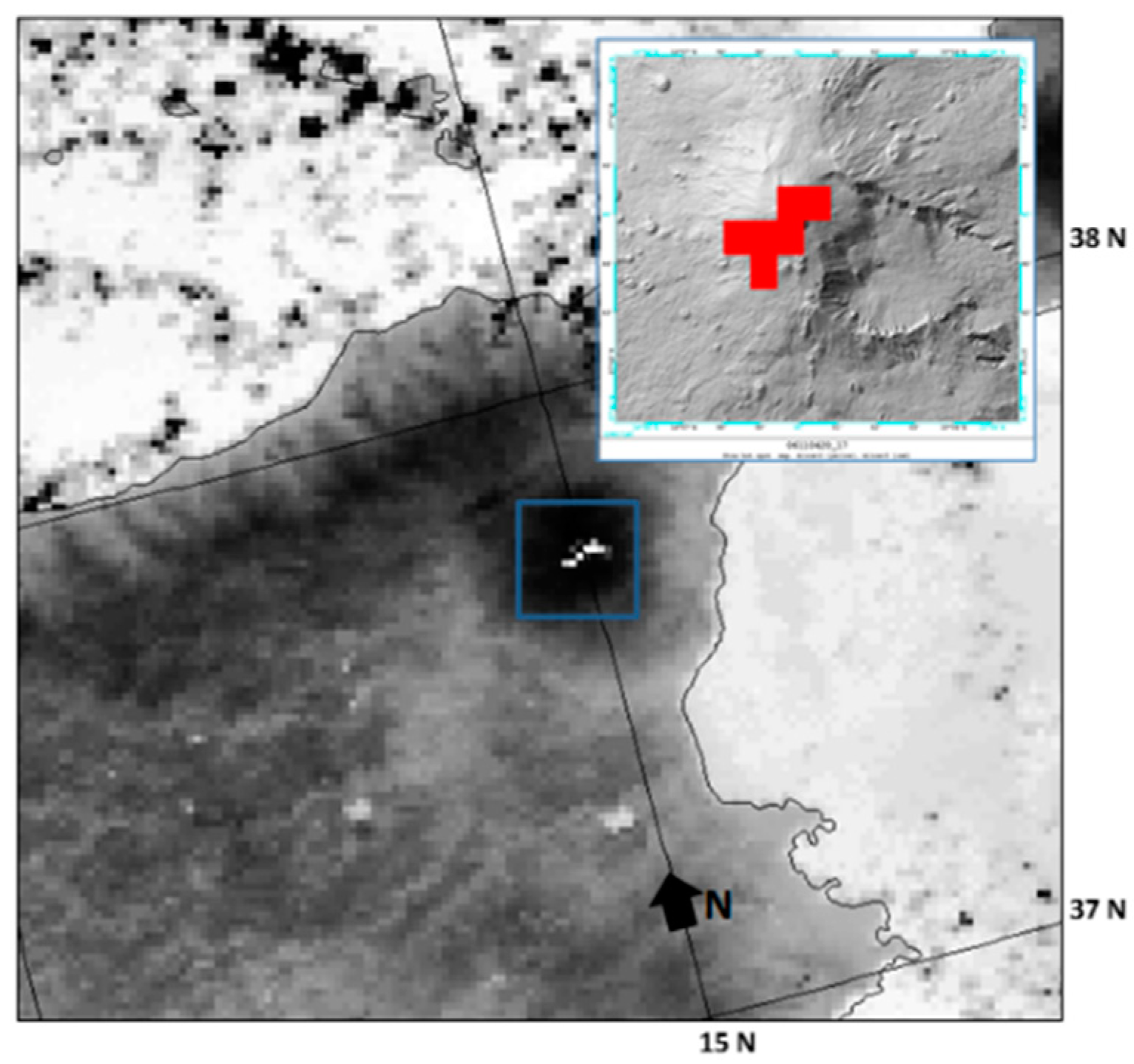
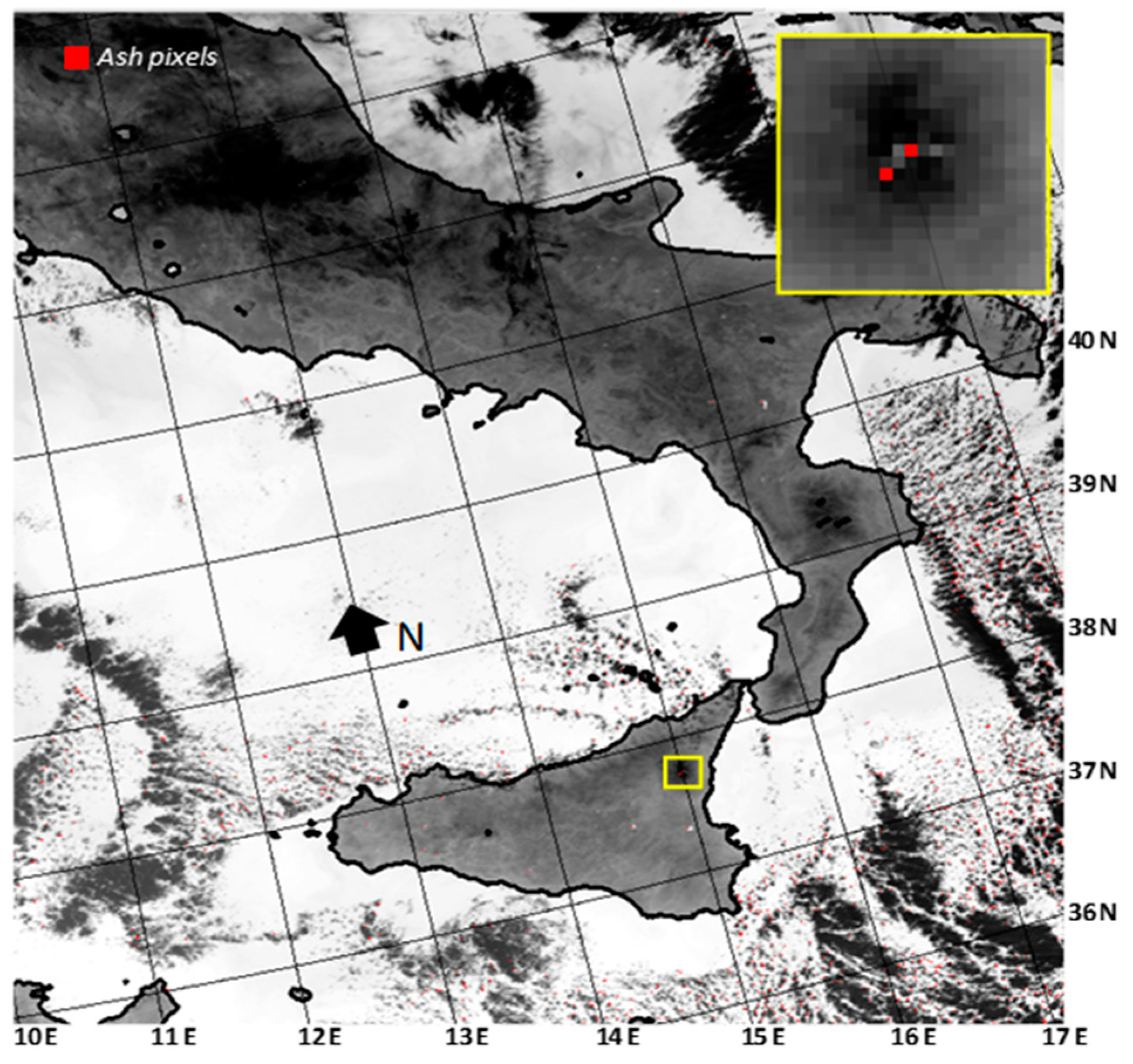
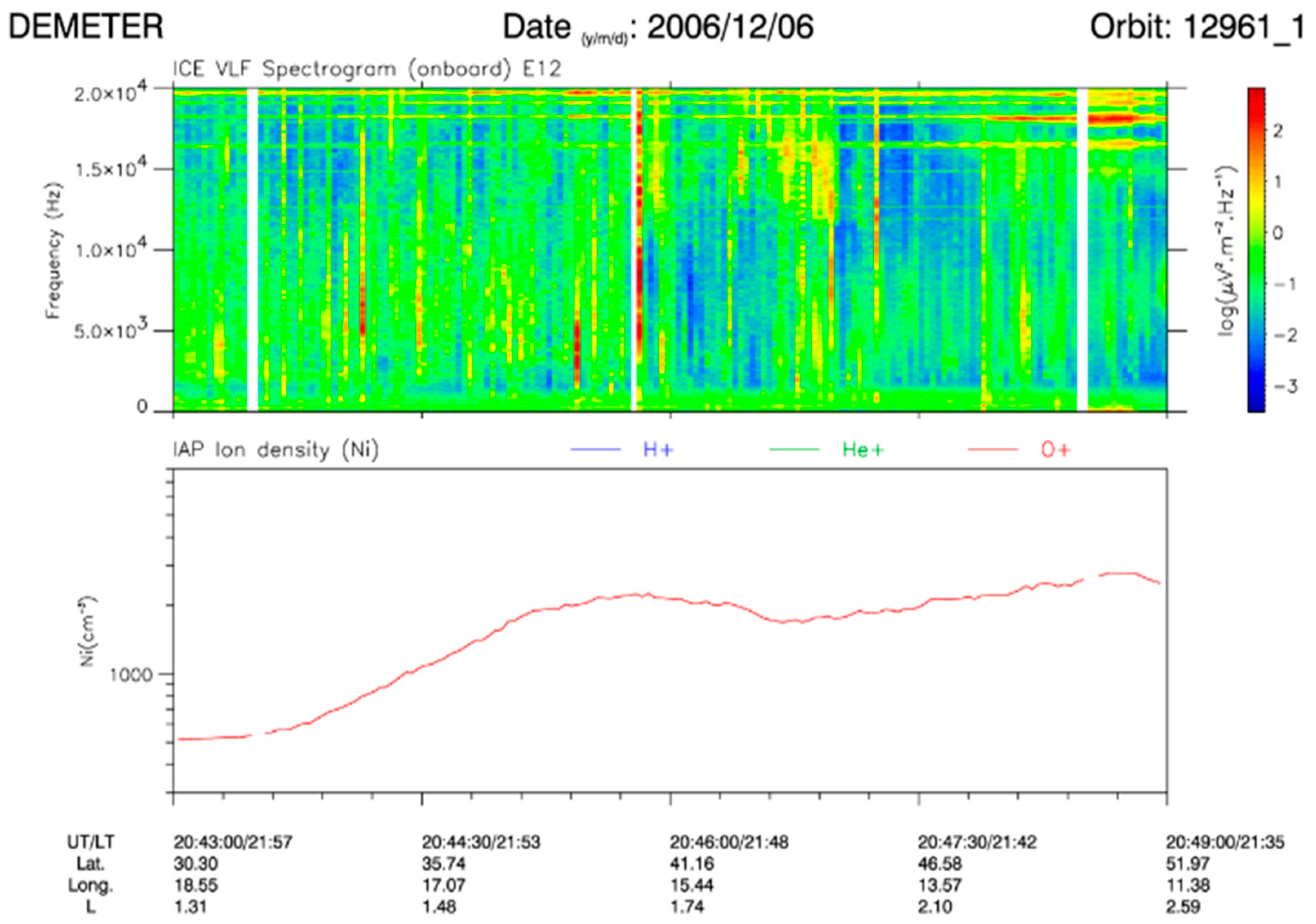
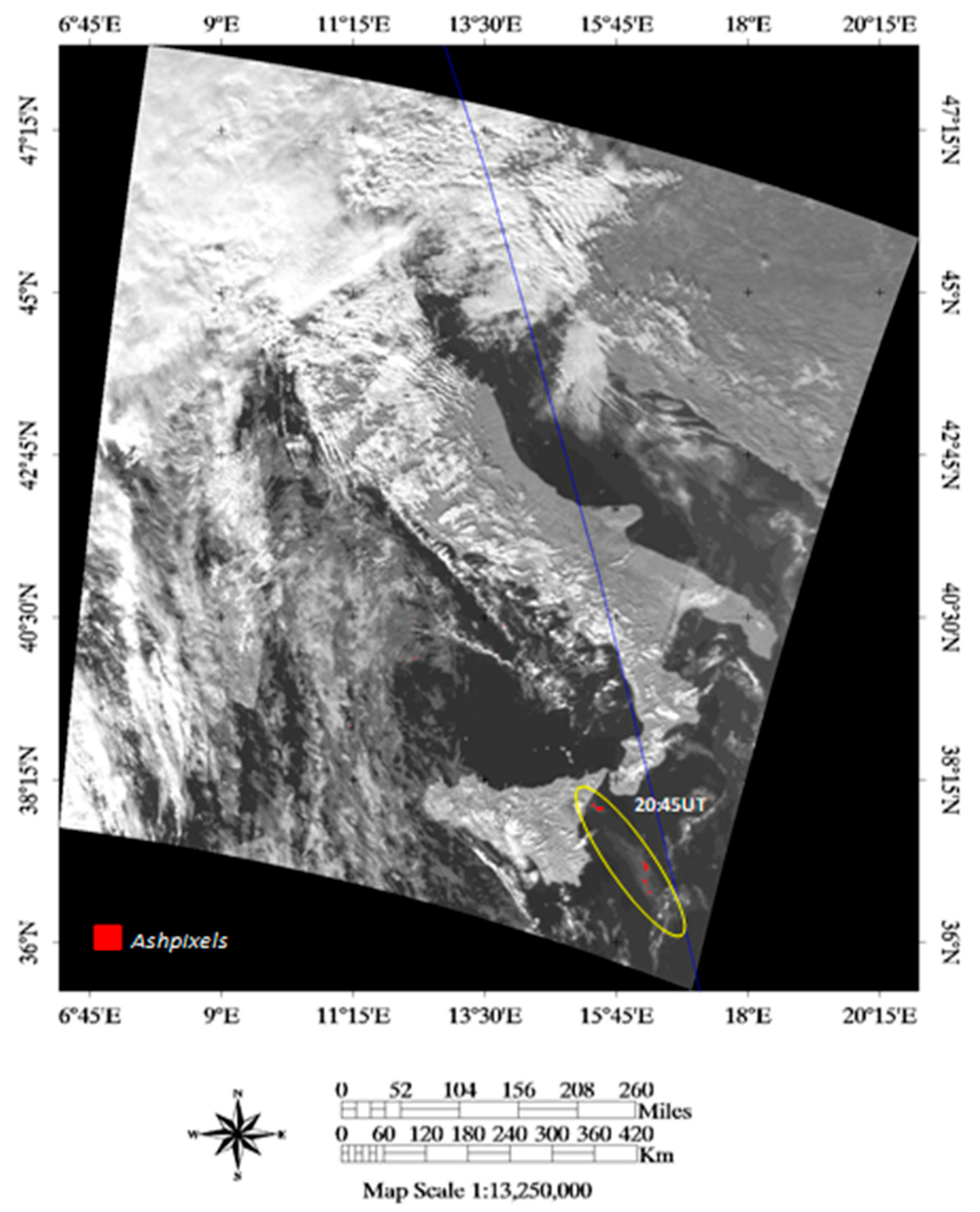
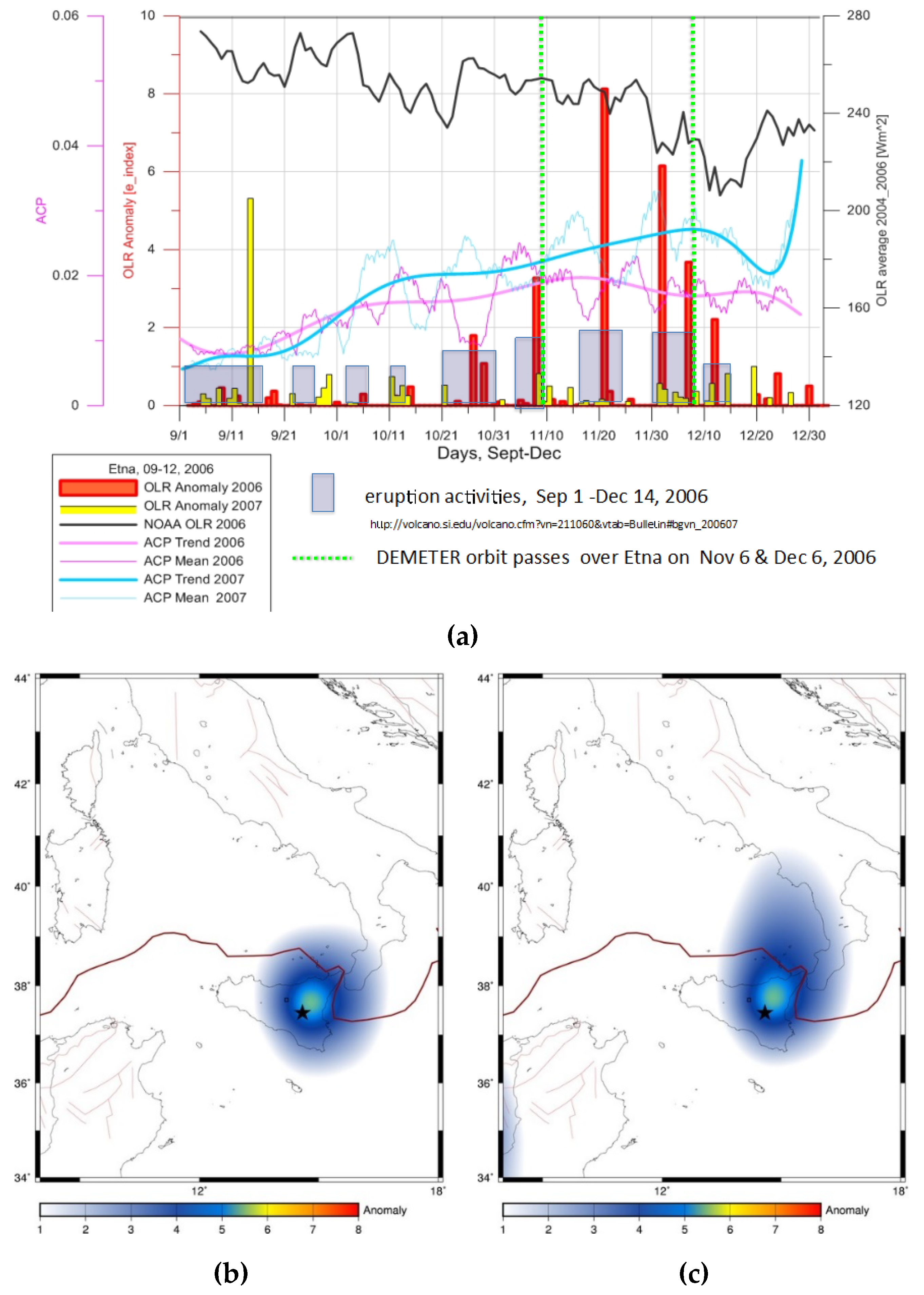
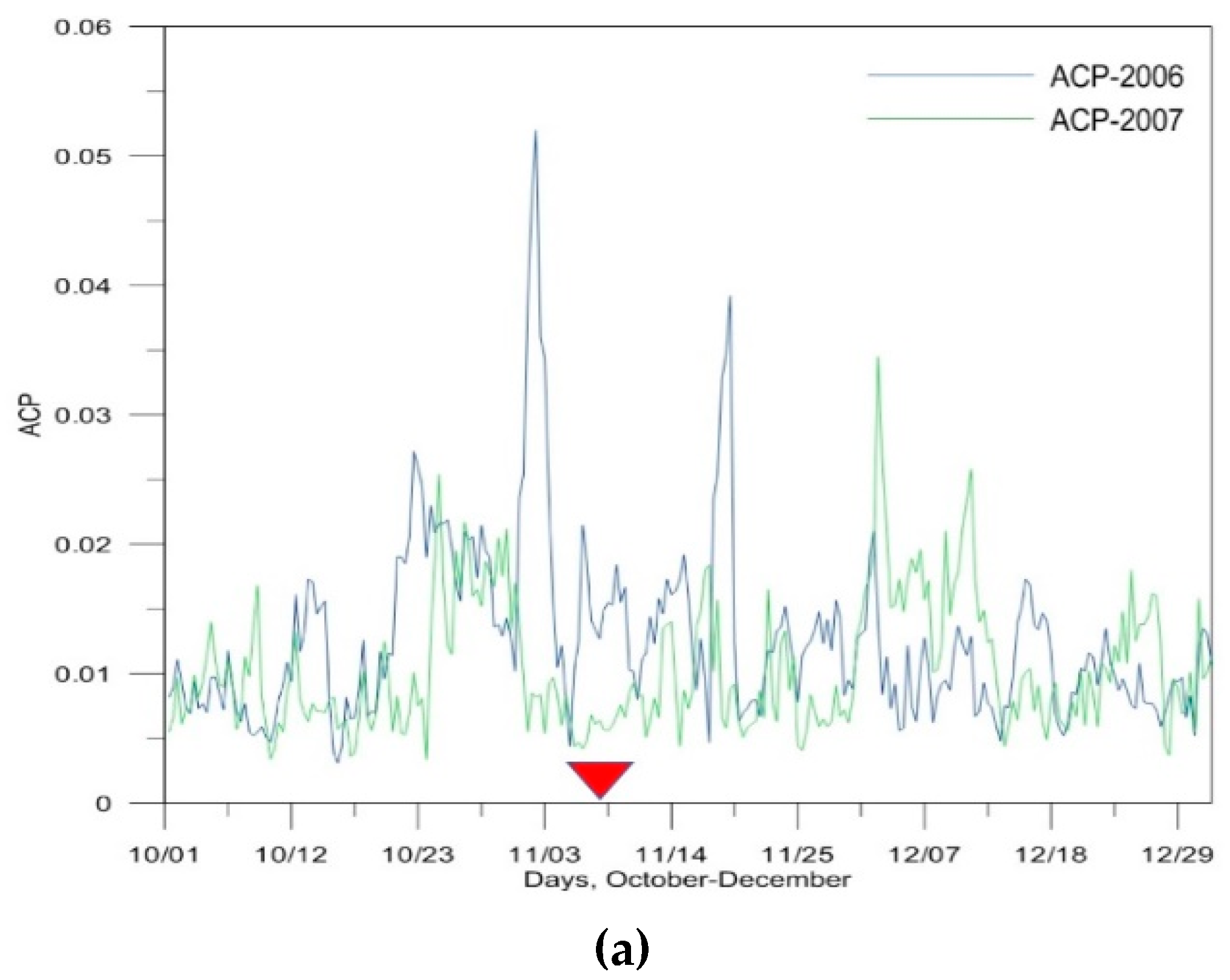
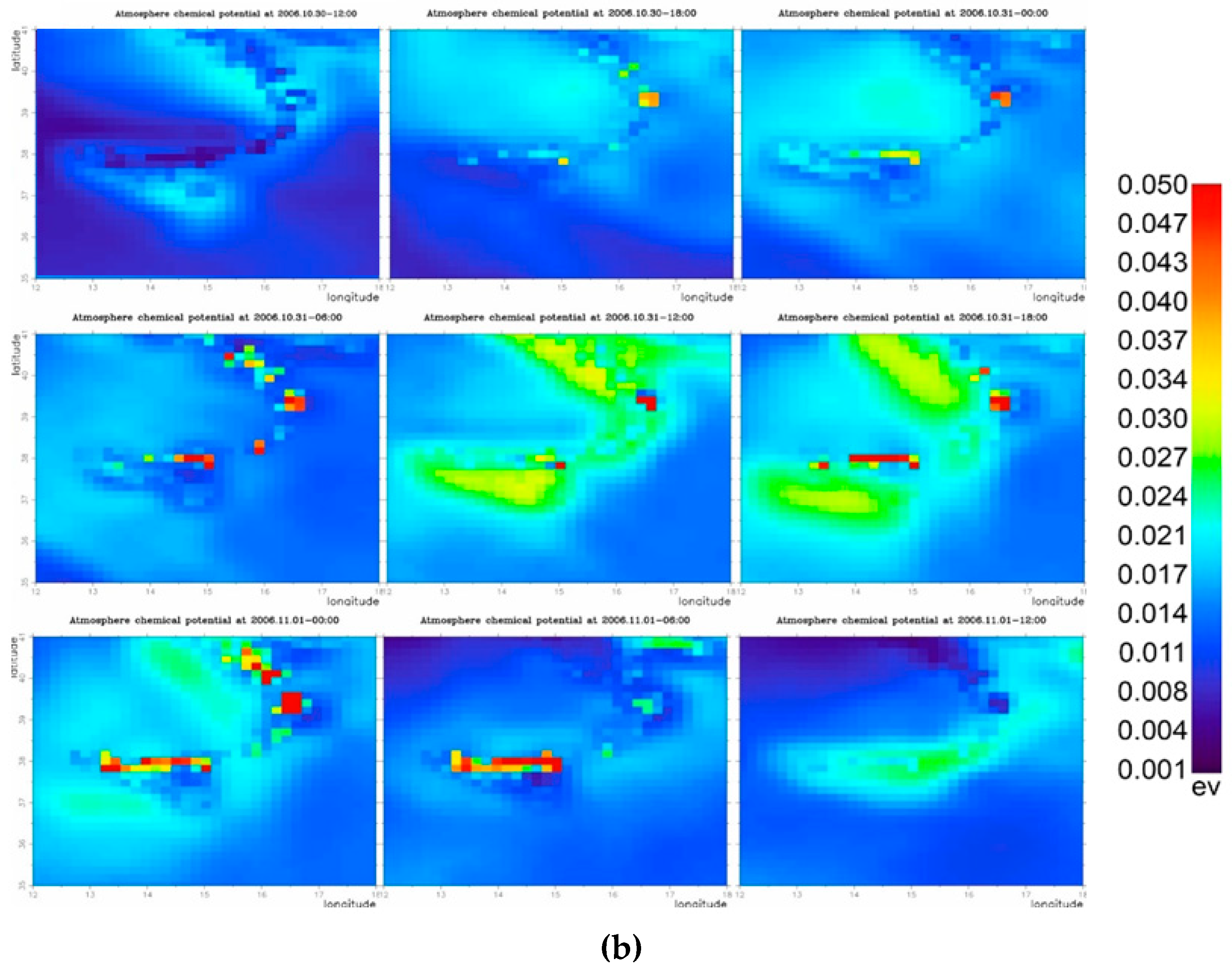
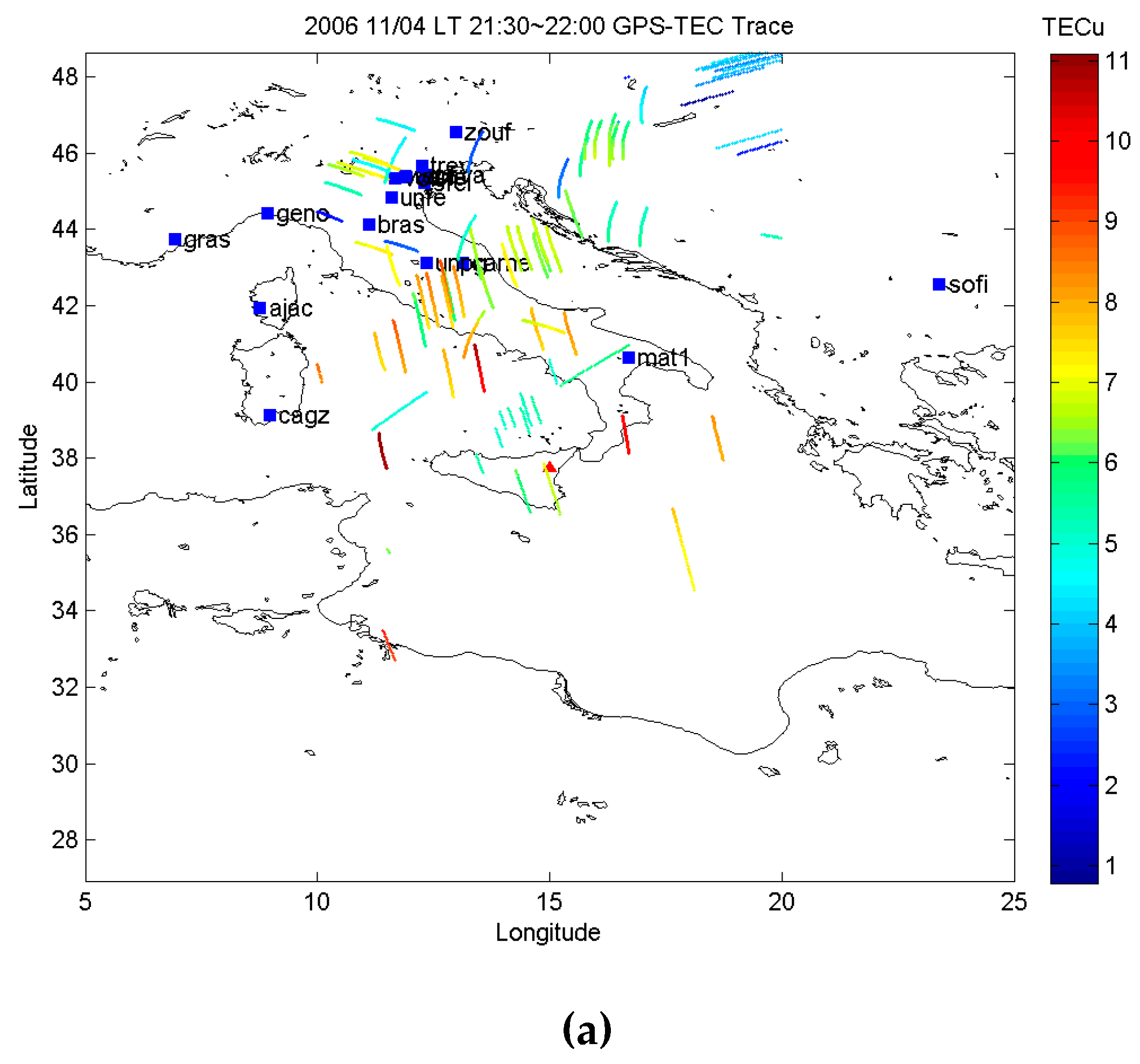
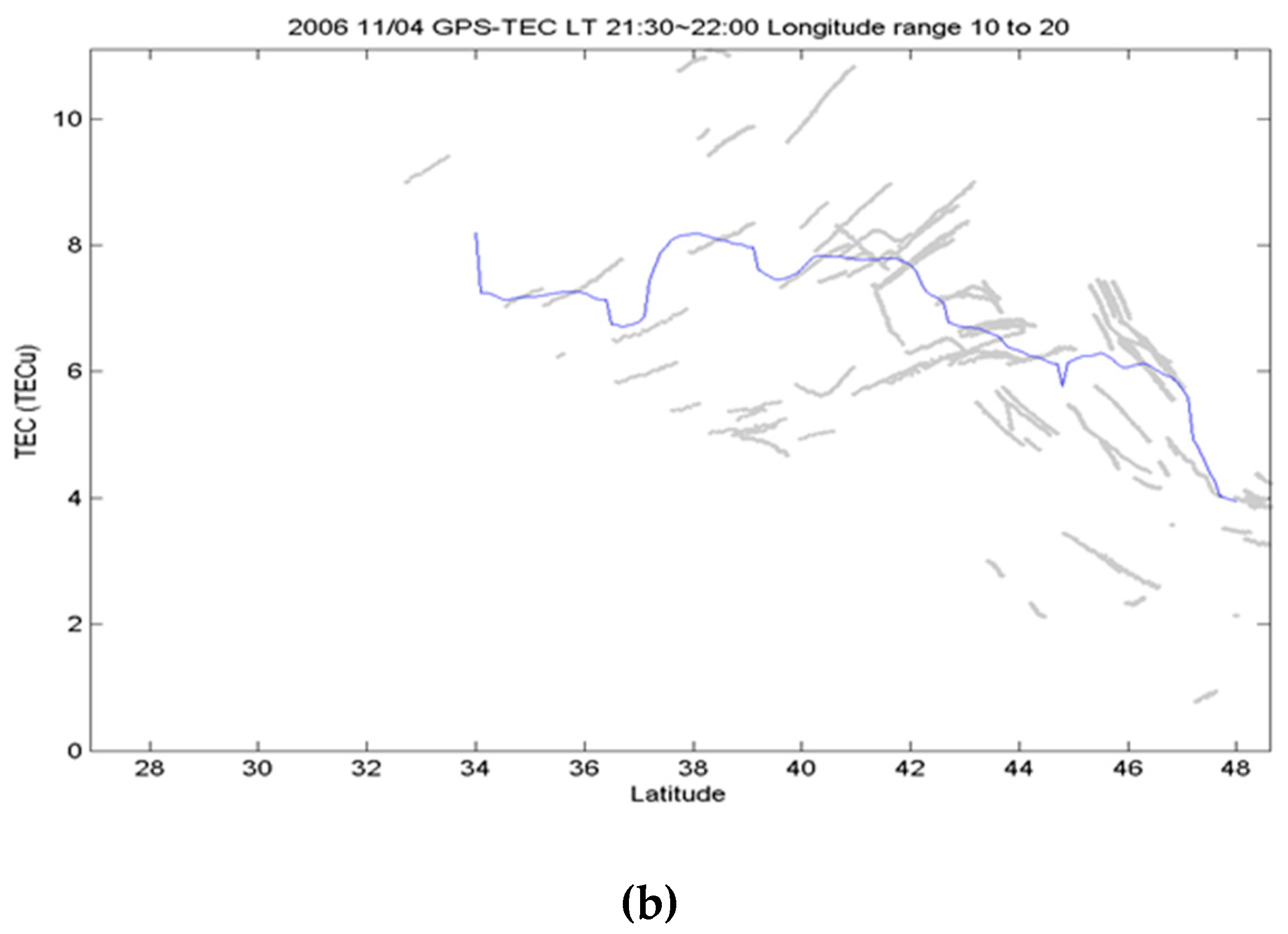
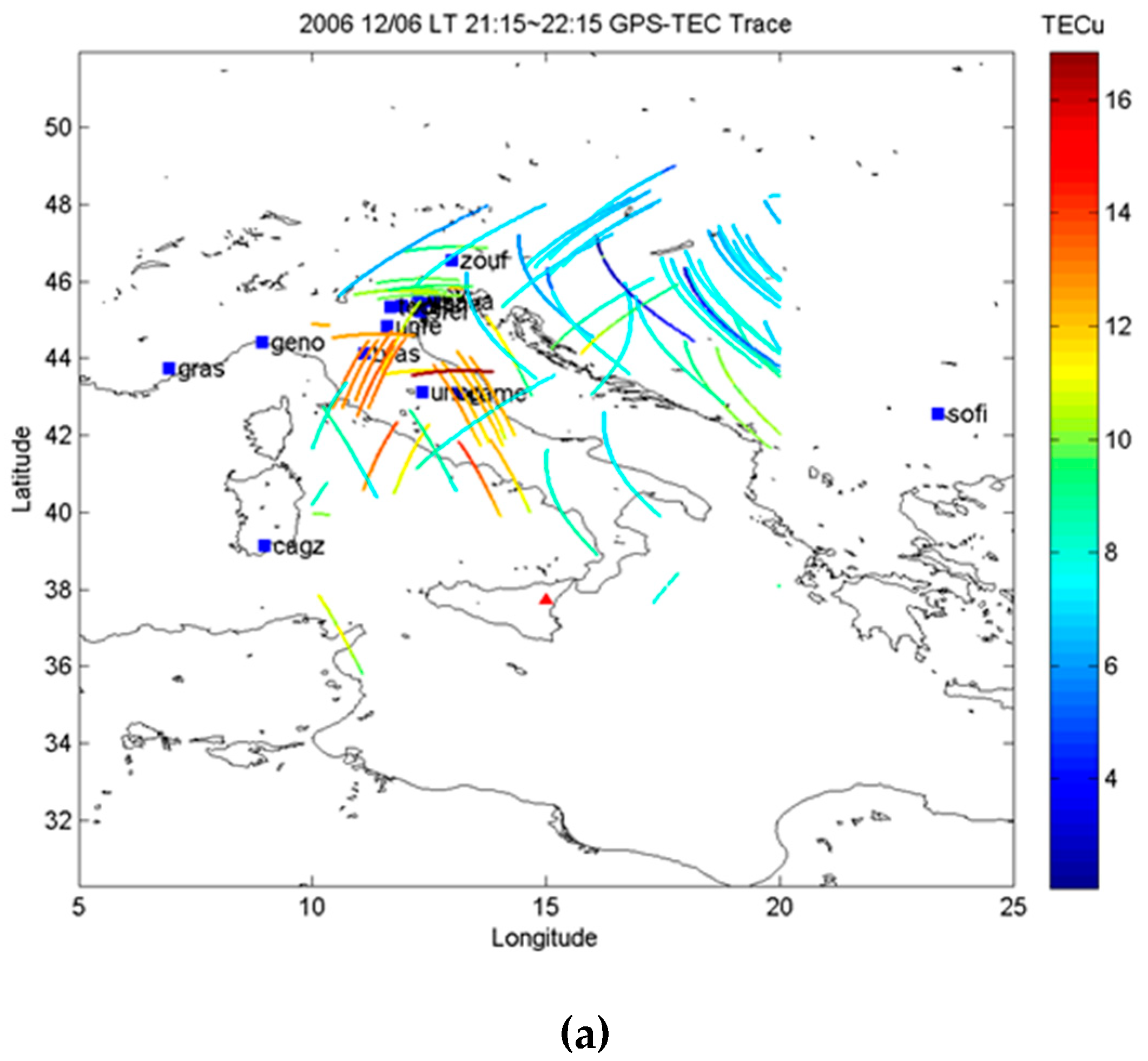
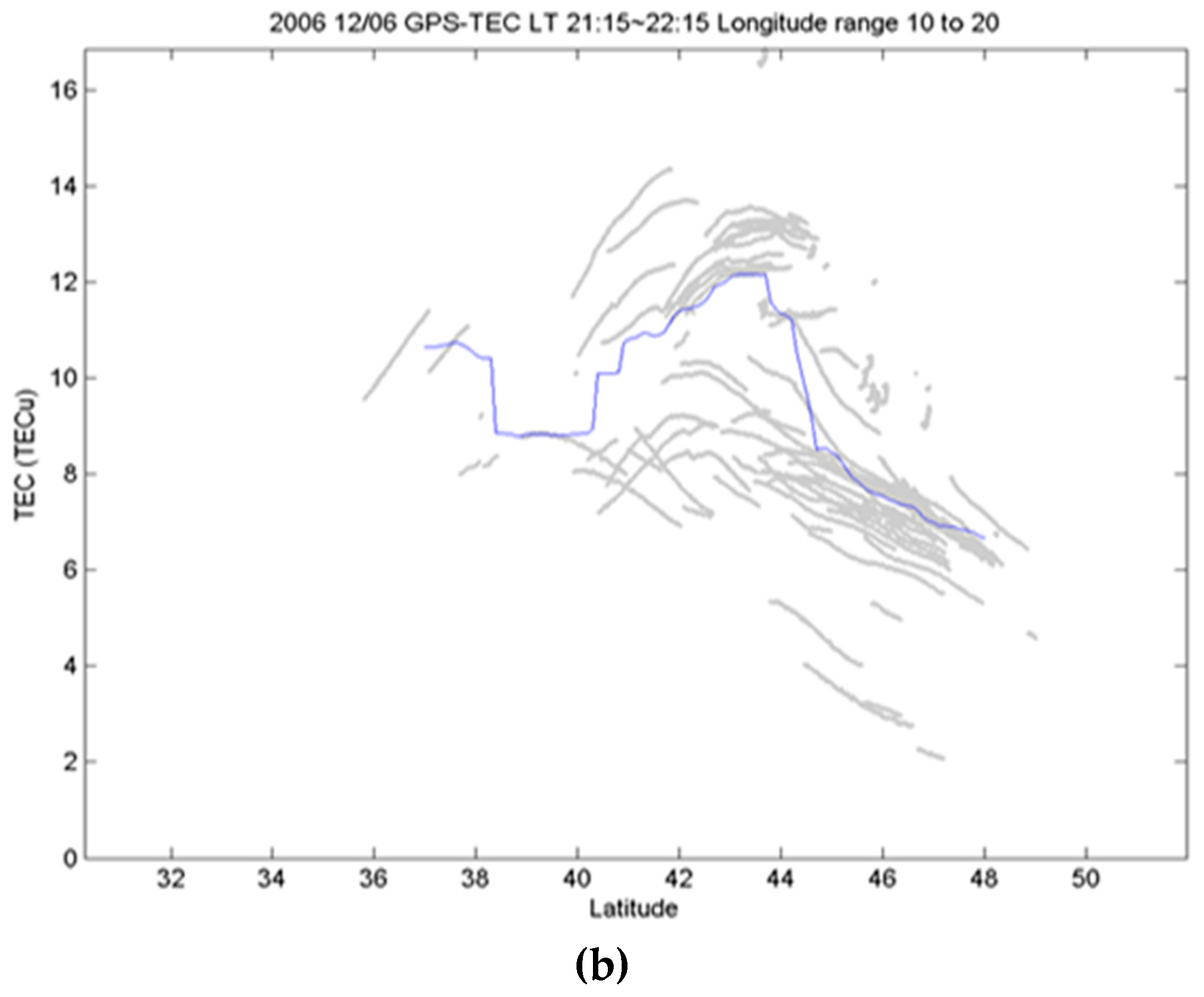
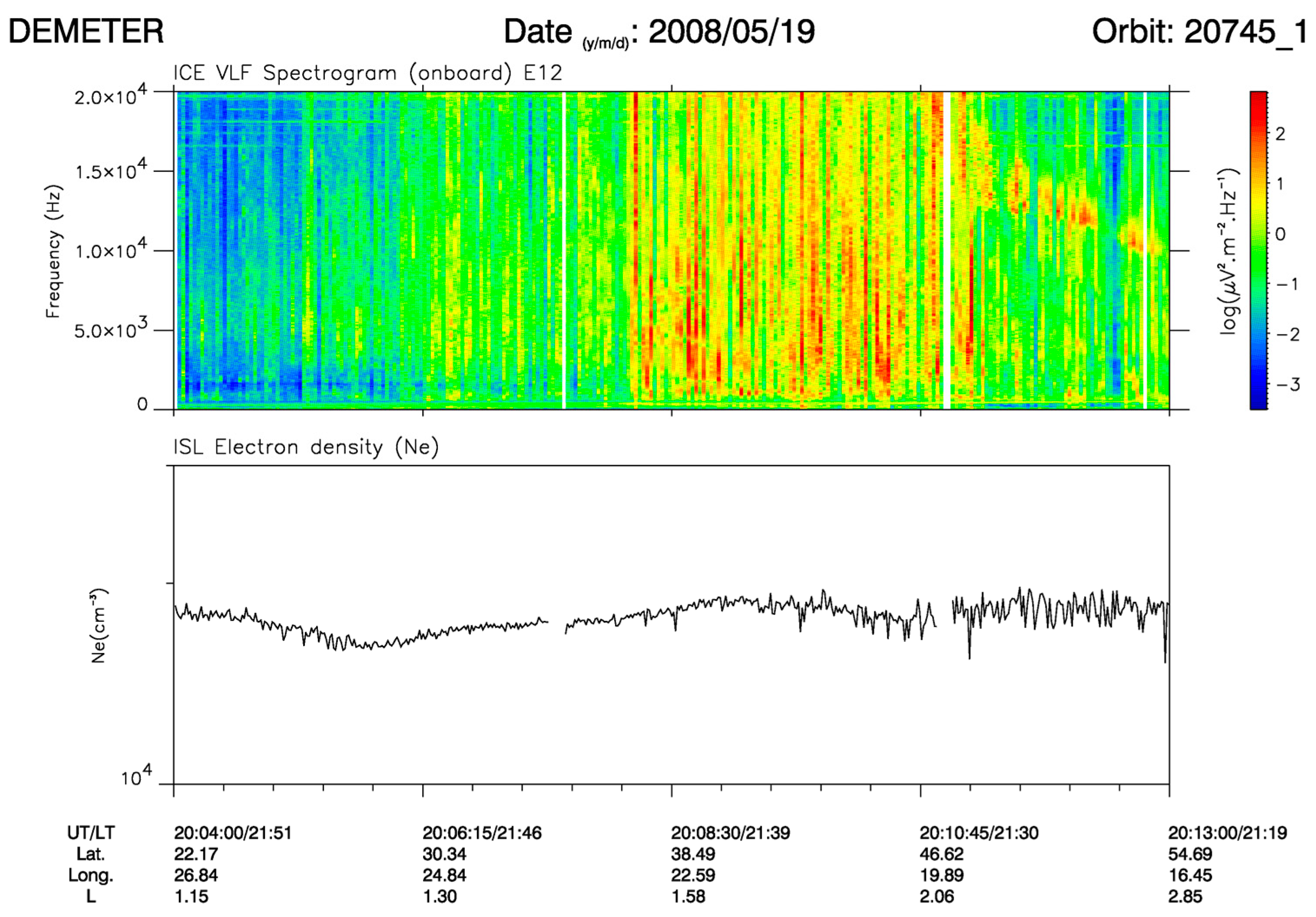
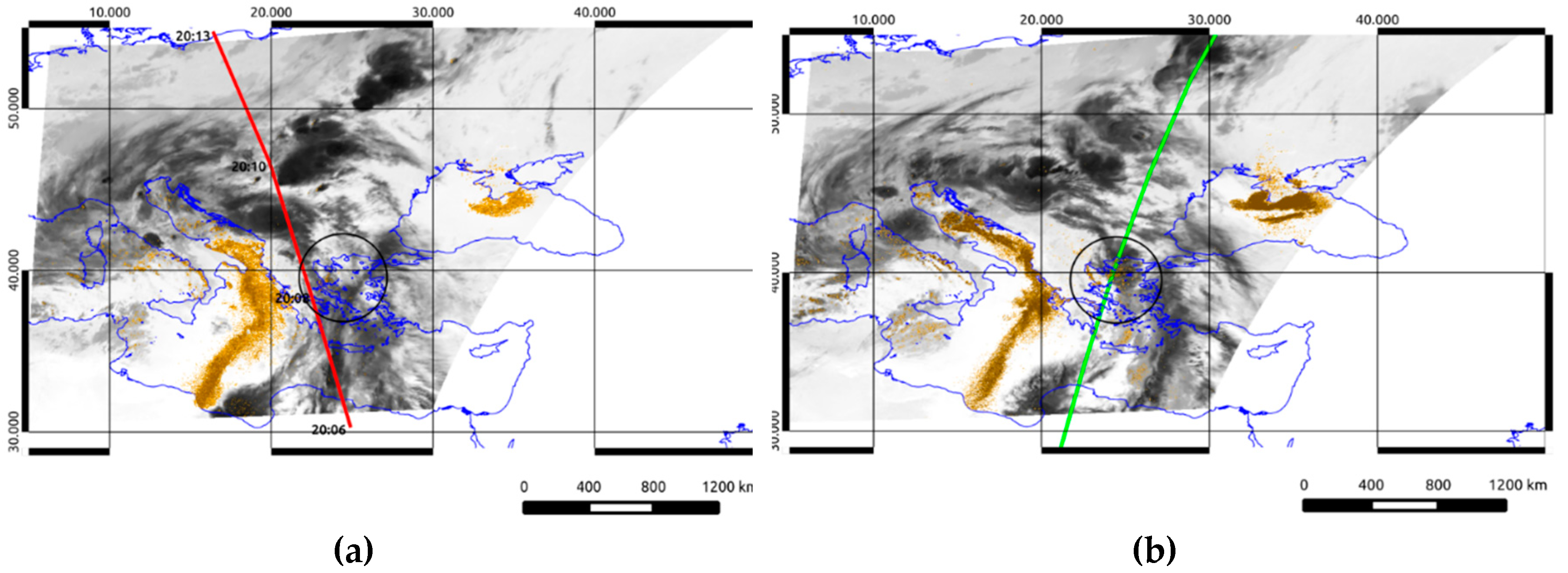
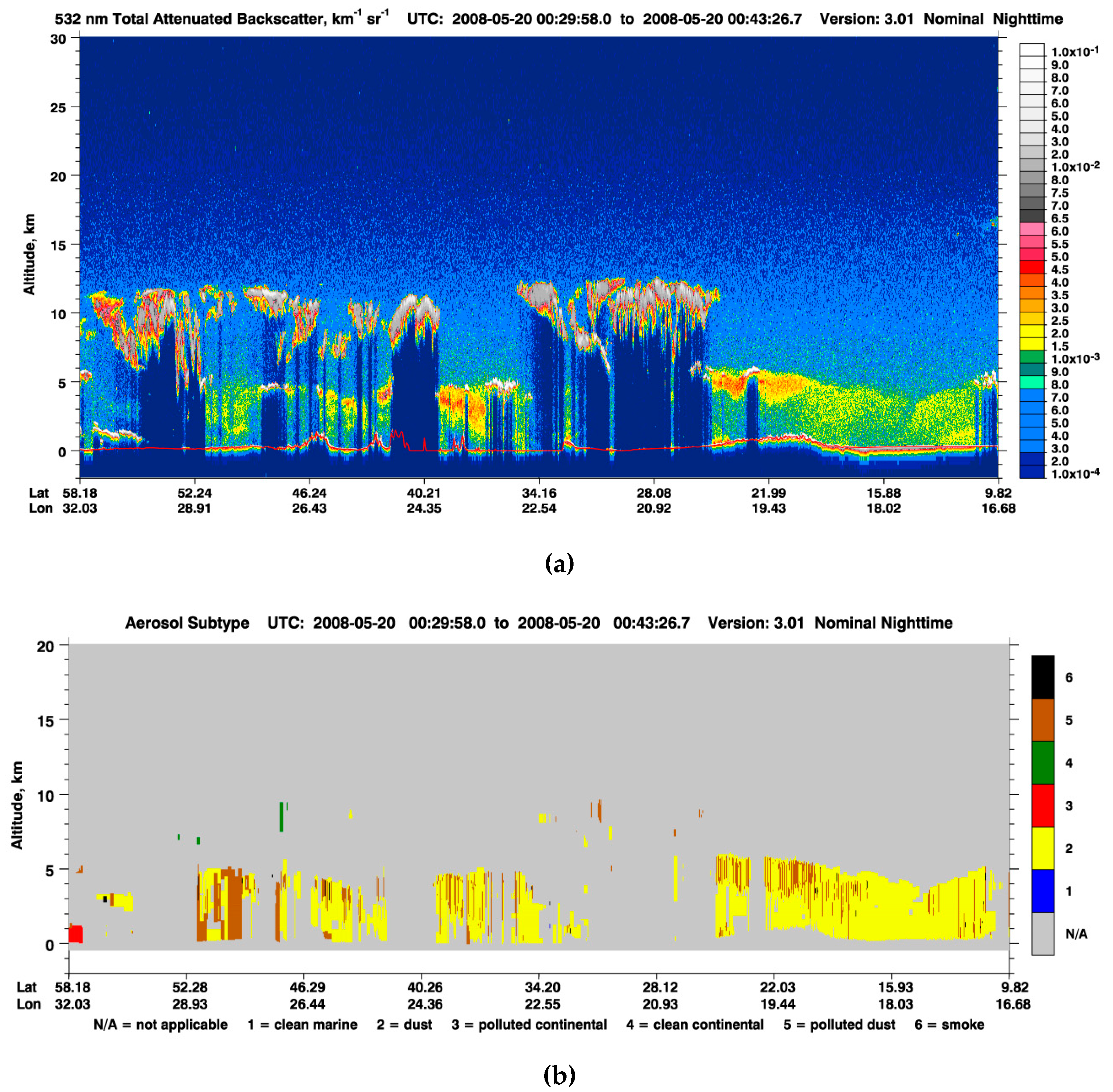
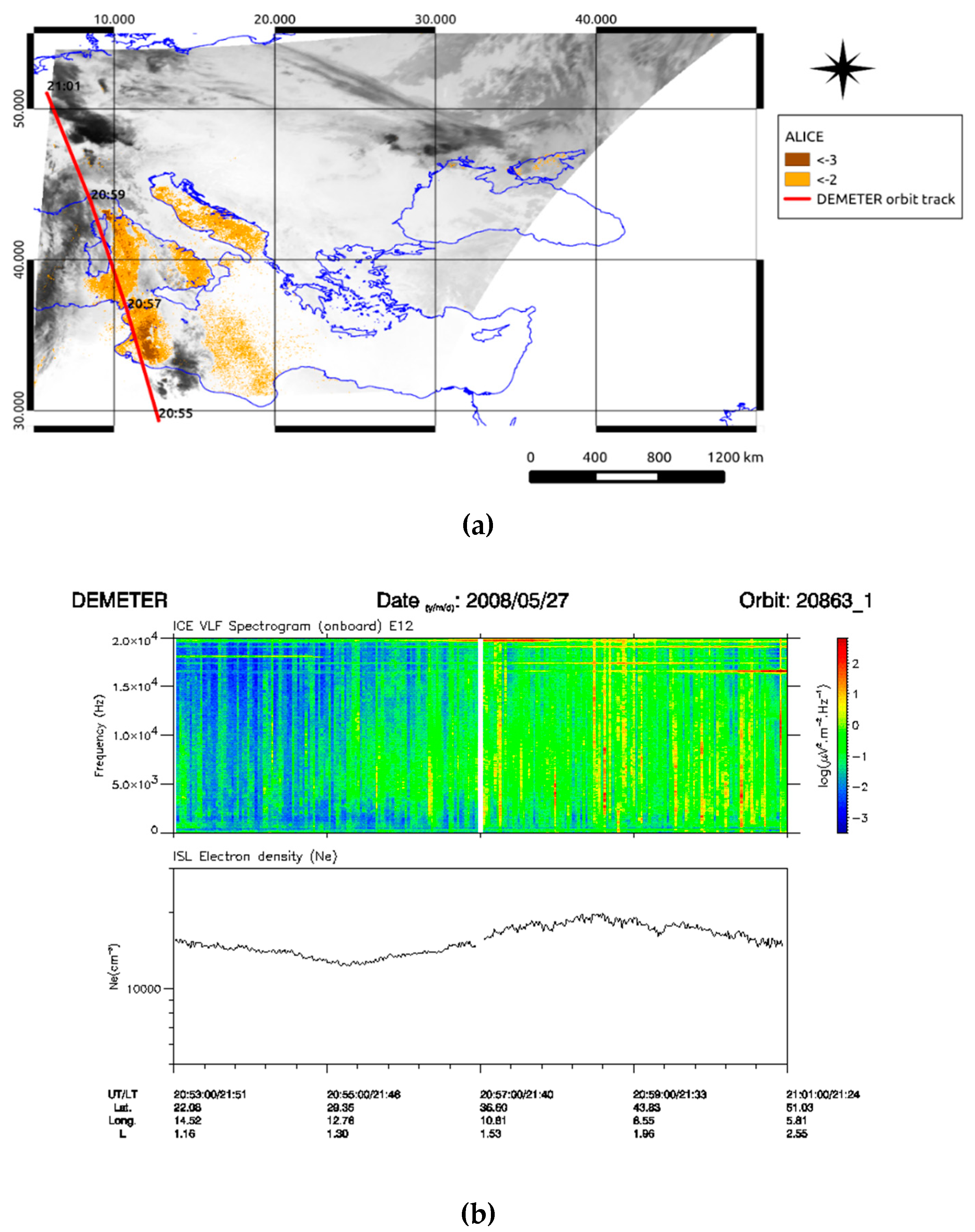
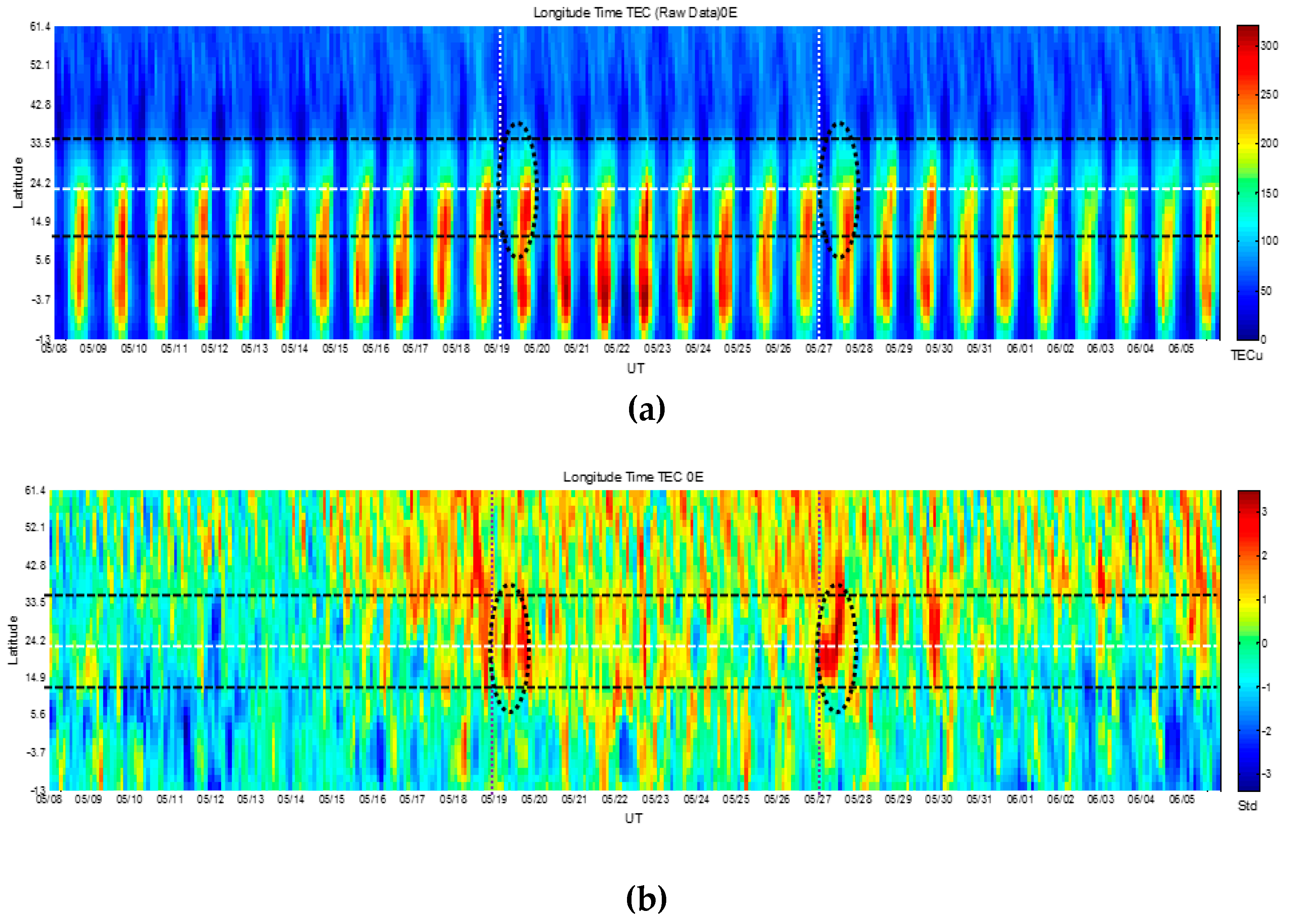
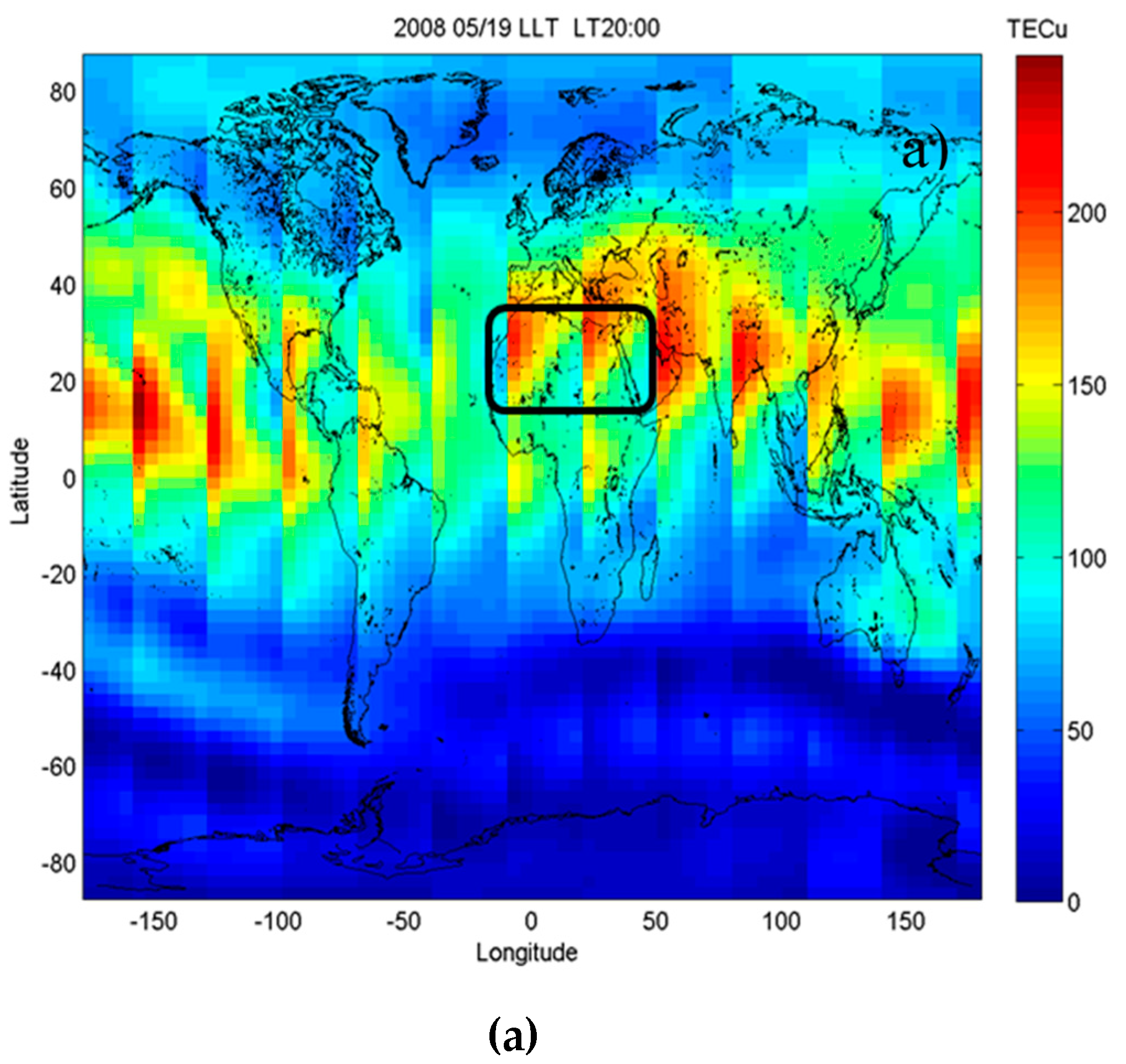
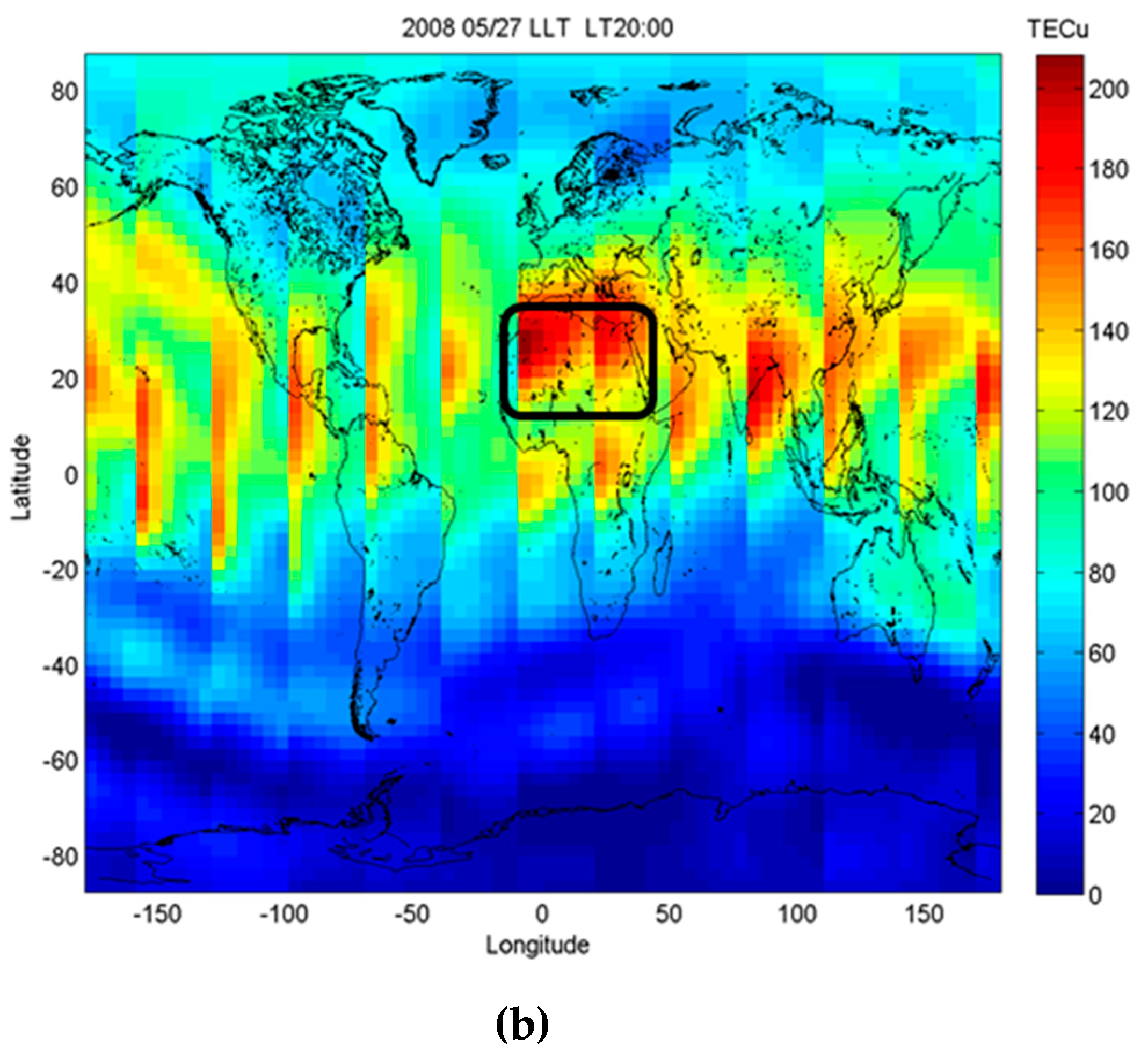
© 2019 by the authors. Licensee MDPI, Basel, Switzerland. This article is an open access article distributed under the terms and conditions of the Creative Commons Attribution (CC BY) license (http://creativecommons.org/licenses/by/4.0/).
Share and Cite
Tramutoli, V.; Marchese, F.; Falconieri, A.; Filizzola, C.; Genzano, N.; Hattori, K.; Lisi, M.; Liu, J.-Y.; Ouzounov, D.; Parrot, M.; et al. Tropospheric and Ionospheric Anomalies Induced by Volcanic and Saharan Dust Events as Part of Geosphere Interaction Phenomena. Geosciences 2019, 9, 177. https://doi.org/10.3390/geosciences9040177
Tramutoli V, Marchese F, Falconieri A, Filizzola C, Genzano N, Hattori K, Lisi M, Liu J-Y, Ouzounov D, Parrot M, et al. Tropospheric and Ionospheric Anomalies Induced by Volcanic and Saharan Dust Events as Part of Geosphere Interaction Phenomena. Geosciences. 2019; 9(4):177. https://doi.org/10.3390/geosciences9040177
Chicago/Turabian StyleTramutoli, Valerio, Francesco Marchese, Alfredo Falconieri, Carolina Filizzola, Nicola Genzano, Katsumi Hattori, Mariano Lisi, Jann-Yenq Liu, Dimitar Ouzounov, Michel Parrot, and et al. 2019. "Tropospheric and Ionospheric Anomalies Induced by Volcanic and Saharan Dust Events as Part of Geosphere Interaction Phenomena" Geosciences 9, no. 4: 177. https://doi.org/10.3390/geosciences9040177
APA StyleTramutoli, V., Marchese, F., Falconieri, A., Filizzola, C., Genzano, N., Hattori, K., Lisi, M., Liu, J.-Y., Ouzounov, D., Parrot, M., Pergola, N., & Pulinets, S. (2019). Tropospheric and Ionospheric Anomalies Induced by Volcanic and Saharan Dust Events as Part of Geosphere Interaction Phenomena. Geosciences, 9(4), 177. https://doi.org/10.3390/geosciences9040177












